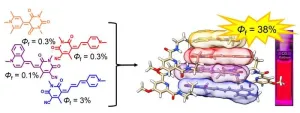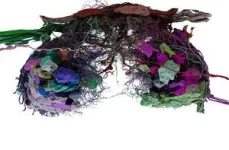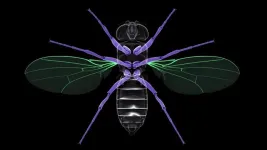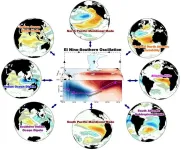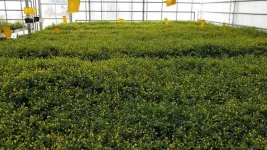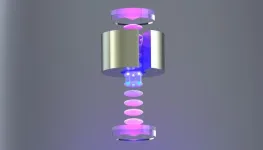(Press-News.org) In order to convert sunlight into electricity or other forms of energy as efficiently as possible, the very first step is an efficient light-harvesting system. Ideally, this should be panchromatic, i.e. absorb the entire spectrum of visible light.
The light-collecting antennae of plants and bacteria are a model for this. They capture a broad spectrum of light for photosynthesis, but are very complex in structure and require many different dyes to transmit the energy of the absorbed light and focus it on a central point.
The light-harvesting systems developed by humans to date also have disadvantages:
Although inorganic semiconductors such as silicon are panchromatic, they only absorb light weakly. In order to absorb enough light energy, very thick layers of silicon in the micrometre range are therefore required – making solar cells relatively bulky and heavy.
Organic dyes that are suitable for solar cells are much thinner: their layer thickness is only around 100 nanometres. However, they are barely able to absorb a broad spectral range and are therefore not particularly efficient.
Thin Layer Absorbs a Lot of Light Energy
Researchers at Julius-Maximilians-Universität (JMU) Würzburg in Bavaria, Germany, in the journal Chem have now presented an innovative light-harvesting system that differs significantly from previous systems.
"Our system has a band structure similar to that of inorganic semiconductors. This means that it absorbs light panchromatically across the entire visible range. And it uses the high absorption coefficients of organic dyes. As a result, it can absorb a great deal of light energy in a relatively thin layer, similar to natural light-harvesting systems," says JMU chemistry professor Frank Würthner. His team from the Institute of Organic Chemistry / Center for Nanosystems Chemistry designed the light-harvesting system at JMU and investigated it together with Professor Tobias Brixner's group from the Institute of Physical and Theoretical Chemistry.
Four Dyes in an Ingenious Arrangement
Put simply, the innovative light-harvesting antenna from Würzburg consists of four different merocyanine dyes that are folded and thereby stacked closely together. The elaborate arrangement of the molecules enables ultra-fast and efficient energy transport within the antenna.
The researchers have given the prototype of the new light-harvesting system the name URPB. The letters stand for the light wavelengths that are absorbed by the four dye components of the antenna: U for ultraviolet, R for red, P for purple, B for blue.
Proven Performance Via Fluorescence
The researchers have demonstrated that their novel light-collecting system works so well by measuring the so-called fluorescence quantum yield. This involves measuring how much energy the system emits in the form of fluorescence. This allows conclusions to be drawn about the amount of light energy that it has previously collected.
The result: the system converts 38 per cent of the irradiated light energy over a broad spectral range into fluorescence - the four dyes on their own, on the other hand, manage less than one per cent to a maximum of three per cent. The right combination and skilful spatial arrangement of dye molecules in the stack therefore make a big difference.
END
Solar technology: Innovative light-harvesting system works very efficiently
2024-06-26
ELSE PRESS RELEASES FROM THIS DATE:
Brain’s ‘escape switch’ controlled by threat sensitivity dial
2024-06-26
Neuroscientists have discovered how the brain bidirectionally controls sensitivity to threats to initiate and complete escape behaviour in mice. These findings could help unlock new directions for discovering therapies for anxiety and post-traumatic stress disorder (PTSD).
The study, published today in Current Biology, outlines how researchers at the Sainsbury Wellcome Centre at UCL studied a region of the brain called the periaqueductal gray (PAG), which is known to be hyperactive in people with anxiety and PTSD. Their ...
Improving prostate cancer screening for transgender women
2024-06-26
Transgender women are still at risk for prostate cancer. A new study led by Cedars-Sinai Cancer investigators, published in the peer-reviewed Journal of the American Medical Association, concludes that current screening guidelines could miss early-stage prostate cancer in transgender women on hormone therapy.
The prostate, a small gland that helps make semen, also produces a protein called prostate-specific antigen, or PSA. Blood levels of PSA tend to be elevated in people who have prostate cancer, and the PSA test, which measures those levels, is a common prostate ...
For healthy adults, taking multivitamins daily is not associated with a lower risk of death
2024-06-26
What: A large analysis of data from nearly 400,000 healthy U.S. adults followed for more than 20 years has found no association between regular multivitamin use and lower risk of death. The study, led by researchers at the National Institutes of Health’s National Cancer Institute, was published June 26, 2024, in JAMA Network Open.
Many adults in the United States take multivitamins with the hope of improving their health. However, the benefits and harms of regular multivitamin use remain unclear. ...
From takeoff to flight, the wiring of a fly's nervous system is mapped
2024-06-26
Work is underway on a wiring diagram of the motor circuits in the central nervous system that control muscles in fruit flies. This connectome, as the wiring diagram is called, is already providing detailed information on how the nerve coordination of leg movements differs from that controlling the wings.
Although fruit flies seem like simple creatures, the researchers said that their motor system contains “an unexpected level of complexity.”
“A typical fly motor neuron receives thousands of synapses from hundreds ...
A chip-scale Titanium-sapphire laser
2024-06-26
As lasers go, those made of Titanium-sapphire (Ti:sapphire) are considered to have “unmatched” performance. They are indispensable in many fields, including cutting-edge quantum optics, spectroscopy, and neuroscience. But that performance comes at a steep price. Ti:sapphire lasers are big, on the order of cubic feet in volume. They are expensive, costing hundreds of thousands of dollars each. And they require other high-powered lasers, themselves costing $30,000 each, to supply them with enough energy to function.
As a result, Ti:sapphire lasers ...
El Niño forecasts extended to 18 months with innovative physics-based model
2024-06-26
Across Asia, the Pacific Ocean, and the Americas, El Niño Southern Oscillation (ENSO) brings variations in winds, weather, and ocean temperature that can cause droughts, floods, crop failures, and food shortages. Recently, the world has experienced a major El Niño event in 2023-2024, dramatically impacting weather, climate, ecosystems, and economies globally. By developing an innovative modeling approach, researchers from the School of Ocean and Earth Science and Technology (SOEST) at the University ...
Scientists discover genetic ‘off switch’ in legume plants that limits biological ability to source nutrients
2024-06-26
A genetic “off switch” that shuts down the process in which legume plants convert atmospheric nitrogen into nutrients has been identified for the first time by a team of international scientists.
Legumes like beans, peas and lentils are unique among crops for their ability to interact with soil bacteria to convert or “fix” nitrogen into a usable form of nutrients. However, this energy-intensive biological process is reduced when nitrogen is already abundant in the soil either through natural processes or through the application of synthetic ...
The Frontiers Planet Prize announces 2024 International Champions
2024-06-26
The Frontiers Planet Prize today (26 June) announced its 2024 International Champions. The Prize recognizes and rewards scientists whose groundbreaking research accelerates solutions to help humanity remain safely within the nine planetary boundaries. The three winning scientists, Dr Pedro Jaureguiberry, Instituto Multidisciplinario de Biología Vegetal (Argentina), Prof Dr Peter Haase, Senckenberg Society for Nature Research (Germany), and Prof Jason Rohr, University of Notre Dame (USA), were each awarded 1.1 million (USD) / 1 million (CHF) to support their research.
The International Champions award-winning research ...
Precision instrument bolsters efforts to find elusive dark energy
2024-06-26
Dark energy — a mysterious force pushing the universe apart at an ever-increasing rate — was discovered 26 years ago, and ever since, scientists have been searching for a new and exotic particle causing the expansion.
Pushing the boundaries of this search, University of California, Berkeley physicists have now built the most precise experiment yet to look for minor deviations from the accepted theory of gravity that could be evidence for such a particle, which theorists have dubbed a chameleon or symmetron.
The experiment, which combines an atom interferometer for precise gravity ...
Overcoming challenges encountered by Spanish-speaking trauma patients
2024-06-26
Key Takeaways
Spanish-speaking patients who suffer traumatic injuries face gaps in their care once they leave the hospital, many with a high need for mental health services.
More than half of the patients studied reported food insecurity, transportation challenges, and needing help with utilities.
A novel care pathway developed by researchers can help connect these patients with needed services.
CHICAGO – Many trauma patients face a myriad of challenges when recovering from a traumatic injury, ...
